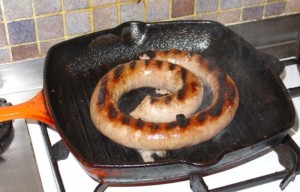
Sausage review: The Humble Cumberland
- Guest Post
- 1
- Posted on
 Ah the Cumberland. The most well known and widespread of the English regional sausages.
Ah the Cumberland. The most well known and widespread of the English regional sausages.
A sausage that has outlived its namesake county, yet still acquired Protected Geographical Indication status, meaning only sausages prepared in the area formerly known as Cumberland may hold the coveted title of Traditional Cumberland Sausage. Tributes to the traditional Cumberland can be found in butchers across the world, some lacking the famous coil, but still holding onto the values of ancient Cumberland, and their proud sausage making heritage.
This particular tribute is crafted by PJ Frankland and Son, of Vauxhall, London. This morning with Son at the counter, a portly fellow of pleasant disposition. A good sign, as the angry butcher is to be avoided – such tensions come across in bruised overworked mince and small goods. The sausages, while not coiled, are promisingly plump and flecked with pepper and various herbs. A sincere ‘alright guv’nor’ on departure, top stuff.
The Cumberland would generally be considered a feature sausage, comprising the main part of the meal, not to be added to a sauce and most certainly not to be curried. As a pork based sausage, it has a milder flavour than the classic British beef sausage, and should be eaten as is, unadulterated. Our plate today is joined by a couple of free range eggs and buttered toast, (and a sly dab of dijon, some habits are hard to break).
With a heavy cast iron pan for an even heat distribution, the sausage changes to a creamy white, with strips of browned skin. A gradual heat prevents the skin splitting*, retaining the rendered fats and juices to cook the sausage from the inside. Small windows appear in the side of the sausage, through which the bubbling transformation can be observed.
At the perfect frying pan temperature, one listens for a soft sizzle, as opposed to the hard sizzle of say a steak on grill. To give an indication to the reader, the soft sizzle sound may be recreated by placing an ear over a glass of slightly flat ginger ale. Gently does it.
At first cut, the texture is not as coarse as one may expect from a traditional Cumberland. But the light grain does give enough to indicate a proper hand prepared sausage. The flavour while mild, does carry through the breakfast and complement the accompanying eggs and toast. A smooth fatty mouth feel finishes off the notes of pepper and something sweeter, possibly nutmeg. The error of the dijon becomes apparent, cutting rather than complementing, lesson learnt. All in all a fine London interpretation, and a fitting tribute to that ancient county.
This particular Cumberland was eaten in the dappled sunlight of English oaks. A pastoral vista is recommended as it is a luxuriant sausage, to be lingered over and enjoyed. Ideally a late winter/early spring morning, before alighting for a gentle walk through a yellow field or country road.
Luxuriant yet humble, its widespread appeal is easy to grasp. The Cumberland shall be a butcher’s staple for many an age to come.
*The inexperienced ‘backseat’ fryer may suggest pricking the skin to prevent the sausage splitting. A gentle but firm word will generally discourage their further input. If they persist, one should remain silent and stare into the pan. Slowly, shift the spatula between your left and right hand. The growing sense of unease will cause them to retreat to the living room or outdoor area, allowing time for the discrete binning of their cheese sizzler six pack.


I refuse to eat something that reminds me of a large tapeworm.